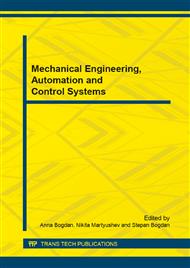[1]
V.N. Kudryavcev, Planetary gear train (in Russian), Mechanical Engineering, Leningrad, (1966).
Google Scholar
[2]
M. Lehmann: Calculation and measurement of forces acting on cycloidal speed reducer (in German), PhD Thesis, Technical University Munich, Germany, (1976).
Google Scholar
[3]
S.K. Malhotra, M.A. Parameswaran, Analysis of a cycloid speed reducer, Mechanism and Machine Theory. 13(6) (1983) 491–499.
DOI: 10.1016/0094-114x(83)90066-6
Google Scholar
[4]
H.S. Yan, T.S. Lai, Geometry design an elementary planetary gear train with cylindrical tooth profiles, Mechanism and Machine Theory. 37 (8) (2002) 757–767.
DOI: 10.1016/s0094-114x(02)00009-5
Google Scholar
[5]
X. Li, W. He, L. Li, L.C. Schmidt, A new cycloid drive with high-load capacity and high efficiency, ASME Journal of Mechanical Design. 126 (2004) 683–686.
DOI: 10.1115/1.1758254
Google Scholar
[6]
J.H. Shin, S.M. Kwon, On the lobe profile design in a cycloid reducer using instant velocity center, Mechanism and Machine Theory, 41 (2006) 596–616.
DOI: 10.1016/j.mechmachtheory.2005.08.001
Google Scholar
[7]
F.L. Litvin, P. Feng, Computerized design and generation of cycloidal gearings, Mechanism and Machine Theory. 31, 7 (1996) 891–911.
DOI: 10.1016/0094-114x(95)00115-f
Google Scholar
[8]
J.G. Blanche, D.C.H. Yang, Cycloid drives with machining tolerances, ASME Journal of Mechanisms, Transmissions and Automation in Design. 111 (1989) 337–344.
DOI: 10.1115/1.3259004
Google Scholar
[9]
P. Davoli, C. Gorla, F. Chiozzi, F. (2007) Theoretical and experimental analysis of a cycloidal speed reducer, 10th ASME International power transmission and gearing conference, 2007, Las Vegas, USA.
DOI: 10.1115/detc2007-34098
Google Scholar
[10]
M. Blagojević, V. Nikolić, N. Marjanović, LJ. Veljović Analysis of cycloid drive dynamic behavior, Scientific Technical Review. LIX, 1 (2009) 52-56.
Google Scholar
[11]
E.A. Efremenkov, S.N. Sorokova, E.E. Kobza, Special aspects in design of double pitch point transmission with intermediate rolling elements, Bulletin of Tomsk Polytechnic University. 323, 2 (2013) 59–62.
Google Scholar
[12]
E.A. Efremenkov, Calculation of Temperature of Heating of Speed Reducers On The Basis of Transmissions with IRB, The 1st International Forum On Strategic Technology, Ulsan, Korea, 2006, p.342–343.
DOI: 10.1109/ifost.2006.312326
Google Scholar


